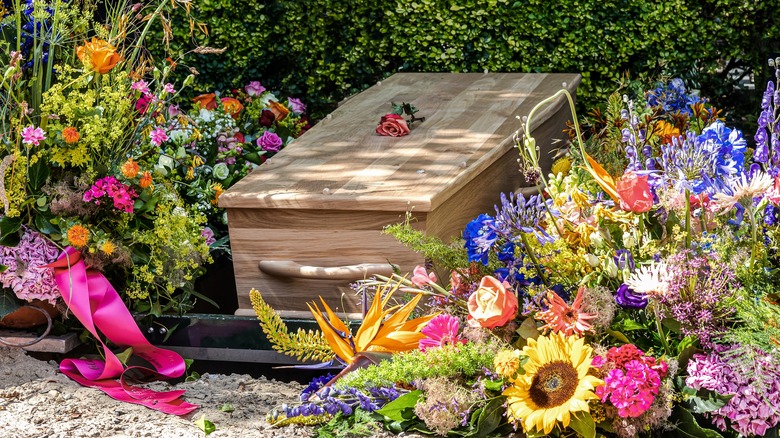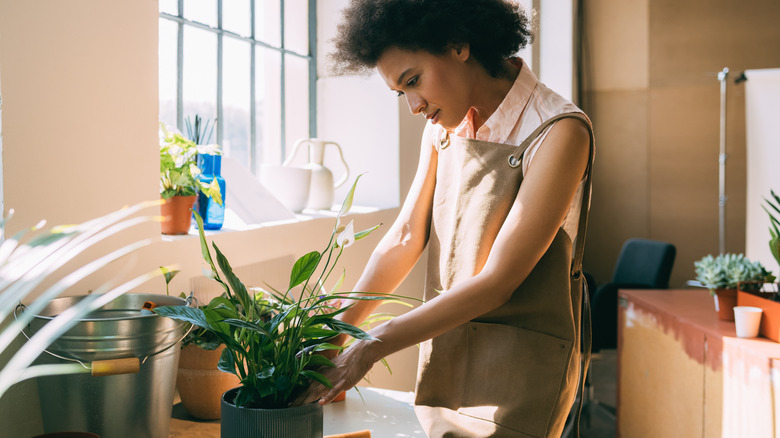How To Take Care Of Funeral Plants: Helpful Tips From Our Master Gardener
There is so much to deal with when a loved one passes away. On top of managing the ceremony arrangements and personal property, you may be overwhelmed with food and gifts. Floral arrangements are at the top of thoughtful offerings from friends and family. The ceremony is often adorned with fresh-cut flowers in lovely vases and beautiful living plants. The concept of sending plants is kind and generous, but for those without a green thumb, it's hard to know what to do with them. Live plant gifts usually come as arrangements with multiple plants in one planter, houseplants, or outdoor plants. Each option requires a different treatment.
While there are many happy occasions for which you might receive plants, those received after a painful loss are extra special. For many, that living plant may feel like a reminder of the lost loved one, so it's unbearable to think it might not survive. These plant gifts also come with specific challenges because of how they are displayed or the region in which they are gifted. Since no one wants water seeping out of planters during a funeral, all live plants come without drainage containers to relieve your plants of excess moisture, so keep that in mind as you decide what to do with your gifts.
Living arrangements
Living arrangements typically include three or more types of plants in a single planter. These plants are tightly packed into a decorative container and are often topped with moss or stones. The variety makes for a stunning display, but they will not survive long in those cramped conditions with no drainage. If they are not transplanted soon, there will be signs of root rot and nutrient deficiencies. Since these plants are combined to create an attractive temporary arrangement, they may not have the same growing requirements for water, light, and humidity.
You do not have to deal with these living arrangements immediately. They should be fine for a couple of weeks after the funeral. When you are ready to transplant into a more appropriate planter for each plant, make sure you know what you have. Google Lens or Visual Look Up are excellent smart phone apps for plant identification. With that knowledge, you can separate each plant in planters with the best soil and proper drainage, which is so important for houseplants. If you feel overwhelmed by the number of plants, this is a nice opportunity to gift a friend to thank them for their support.
Houseplants
Single houseplants are less complicated than arrangements of live plants, but they still come with challenges. If you are careful with watering, you should be able to leave houseplants in their gift planter until you're ready to deal with them. Before you do anything, get a positive ID on the plant, especially if you have children or pets. Some popular funeral plants, like peace lilies (Spathiphyllum), are mildly toxic to cats and dogs, according to the ASPCA. Other plants, like Easter lilies (Lilium longiflorum), are deadly to cats. If you've got pets or kids, always be careful when bringing new plants into the house.
Once you know your houseplant is safe for your pets and children, you may need to transplant it. Funeral plants often arrive root-bound. The most beautiful plants have exceptionally full foliage, but that may also be a sign that it's time for a bigger planter. Sometimes, live plants arrive in a plastic nursery pot inside a decorative planter. If you see roots coming out of the bottom, you need to move your plant to a larger pot. If not, you may be able to keep the plant in its current planter if you check frequently to make sure water is not building up at the bottom of the pot since there's no drainage. Of course, you can always transplant your gift into a planter with drainage that matches your style, turning a funeral plant into a permanent part of your home.
Outdoor plants
Plants that can be grown outdoors are tricky, especially if you are unfamiliar with landscaping. Potted azaleas, hydrangeas, and even small trees are often available as funeral plants. In some situations, the purpose of these types of plants is to be planted as a living memorial — a beautiful gesture. Others may not transplant well. Small blooming hydrangeas are popular options, but they can be challenging to grow. With any luck, your plant will come with identification that will help ensure it's appropriate for your USDA Hardiness Zone. If it is, it may take some research to determine when and where you should plant it.
If the gift is inappropriate for your region, you can enjoy it as an annual while the weather cooperates. You may also be able to grow your gift in a planter that you bring inside during the winter. How you manage outdoor plants depends entirely on where you live and the type of plant you have. Whatever happens, remember that plants that are sent as funeral gifts may or may not be temporary, and you have no obligation to keep them. If you are uncomfortable caring for these items, you can always pass them on to a plant-loving friend who will enjoy them.



